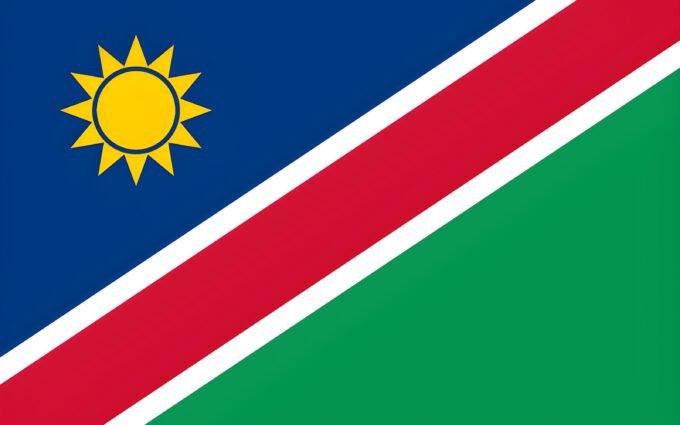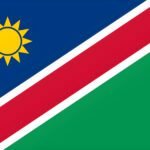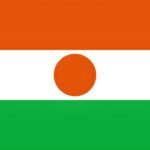Namibia Flag: National Flag of Namibia Free Download

Introduction
The national flag of Namibia is a symbol of pride and identity for the people of this beautiful African country. It represents the rich history, culture, and aspirations of the Namibian people. If you are interested in downloading the Namibia flag for personal or educational purposes, you have come to the right place.
1. What is the Meaning of the Flag of Namibia?
The flag of Namibia is a symbol of the country’s unity and independence. It consists of a blue field with a diagonal red stripe running from the lower hoist-side corner to the upper fly-side corner. The blue represents the Namibian sky and the Atlantic Ocean, while the red symbolizes the people’s determination for freedom and justice. The white sun in the top left corner represents peace, and the green represents the country’s vegetation and agricultural resources.
2. Why is Namibia Famous?
Namibia is famous for its stunning landscapes, including the Namib Desert, the Skeleton Coast, and the Etosha National Park. The country offers unique wildlife experiences, such as observing desert-adapted elephants and rhinos, as well as opportunities for adventure activities like sandboarding and dune hiking. Namibia is also known for its rich cultural heritage, with diverse ethnic groups and traditional communities.
3. Which Country is Namibia in?
Namibia is located in southwestern Africa, sharing borders with Angola to the north, Zambia and Botswana to the east, and South Africa to the south and southeast. It also has a coastline along the Atlantic Ocean to the west.
4. What Language is Spoken in Namibia?
Namibia is a multilingual country with several recognized languages. The official language is English, which is widely spoken and used for business and administration. However, the most commonly spoken language among the local population is Oshiwambo, followed by Damara/Nama, Herero, and Afrikaans. Additionally, German is still spoken by some Namibians due to the country’s colonial history.
5. Why is Namibia So Uninhabited?
Namibia is known for its vast and sparsely populated areas due to its arid climate and harsh desert landscapes. The Namib Desert, which stretches along the entire coastline, is one of the oldest and driest deserts in the world. The lack of water and inhospitable conditions make it challenging for large populations to settle in many parts of the country. As a result, Namibia has a relatively low population density compared to other countries.
6. Is Namibia Nice to Live In?
Many people find Namibia to be a wonderful place to live due to its natural beauty, peaceful atmosphere, and friendly communities. The country offers a high quality of life, with a low crime rate, excellent healthcare facilities, and a well-developed infrastructure. Namibia’s diverse landscapes and wildlife also provide unique opportunities for outdoor activities and exploration. However, the decision to live in Namibia ultimately depends on individual preferences and circumstances.
7. Why is Namibia So Expensive?
Although Namibia is considered relatively expensive compared to some neighboring countries, the cost of living can vary depending on the location and lifestyle. The main factors contributing to the higher costs include the country’s remote and sparsely populated areas, which require extensive infrastructure and logistics for goods and services. Additionally, imported goods and certain commodities can be more expensive due to transportation and import duties. However, there are also affordable options available, especially in larger cities like Windhoek.
8. What Religion is Namibia?
Namibia is a religiously diverse country. The majority of the population adheres to Christianity, with various denominations represented, including Lutheran, Anglican, Roman Catholic, and Methodist. Traditional indigenous beliefs and practices also play a significant role in the lives of many Namibians. Additionally, there are minority communities practicing Islam, Hinduism, and Judaism.
9. What is the Most Popular Food in Namibia?
One of the most popular traditional dishes in Namibia is called “kapana,” which consists of grilled or barbecued meat, usually beef or sausage, served with a variety of sauces and condiments. Other traditional Namibian foods include “potjiekos” (a slow-cooked meat and vegetable stew), “bobotie” (a spiced minced meat dish with an egg-based topping), and “vetkoek” (deep-fried dough bread served with various fillings). Namibia also offers a range of international cuisines, particularly in urban areas.
10. What is Hello in Namibia?
In Namibia, the most commonly used greeting is “Hello” or “Hi,” which is widely understood and accepted. However, it is also appreciated when visitors make an effort to learn and use basic greetings in the local languages, such as “Moro” in Oshiwambo or “Goeie dag” in Afrikaans.
11. Why is Namibia So Rich?
Namibia is often considered a resource-rich country due to its significant mineral deposits, including diamonds, uranium, and other valuable minerals. The mining industry plays a crucial role in the country’s economy and contributes to its wealth. Additionally, Namibia has a stable political environment, a well-regulated financial sector, and a growing tourism industry, which further contribute to its overall economic prosperity.
12. Can You Swim in Namibia Beaches?
While Namibia has a beautiful coastline along the Atlantic Ocean, swimming in the ocean is not as common as in other beach destinations. The waters along the Namibian coast can be quite cold due to the Benguela Current, which brings cold water from the Antarctic. However, there are some areas where swimming is possible, especially in protected bays and lagoons. It is always important to check local conditions and follow any safety warnings or guidelines provided.
13. Why Are There So Many Germans in Namibia?
The presence of Germans in Namibia can be attributed to the country’s colonial history. Namibia was a German colony from 1884 until 1915 when South Africa took control during World War I. Many Germans migrated to Namibia during the colonial period, and their influence can still be seen today in the architecture, language, and cultural practices. The German community in Namibia has maintained its traditions and heritage, and German is still spoken by some Namibians.
14. Can an American Live in Namibia?
Yes, Americans can live in Namibia. The country welcomes foreign residents and offers various types of visas and permits for individuals who wish to live, work, or retire in Namibia. It is important to familiarize yourself with the immigration requirements and processes before making any plans to live in the country. Consulting with the Namibian embassy or consulate in your home country can provide you with the most up-to-date information and guidance.
15. Is Namibia Very Hot?
Namibia has a predominantly arid and semi-arid climate, which means that it can get very hot, especially during the summer months. Temperatures can reach well above 30 degrees Celsius (86 degrees Fahrenheit) in many parts of the country, particularly in the desert regions. However, Namibia also experiences significant temperature variations between day and night, with cooler temperatures in the early mornings and evenings.
16. Is it Safe for Americans to Travel to Namibia?
Yes, it is generally safe for Americans to travel to Namibia. Namibia is known for its political stability and low crime rates compared to other African countries. However, it is always important to exercise caution and take necessary safety precautions while traveling, just like in any other destination.
17. What is the White Population in Namibia?
The white population in Namibia is estimated to be around 6% of the total population. Most of the white Namibians are of German, British, or Afrikaner descent, with a smaller number of Portuguese and other European origins. The white community has played a significant role in Namibia’s history and continues to contribute to various sectors of the country’s economy and society.
18. What is the Staple Food of Namibia?
The staple food of Namibia varies among different ethnic groups and regions. However, maize (corn) is widely consumed and forms a significant part of the Namibian diet. It is used to make a variety of dishes, including porridge, maize meal, and bread. Millet and sorghum are also commonly used in traditional Namibian cuisine, particularly among the rural communities.
19. Are Namibians Muslims?
No, the majority of Namibians are not Muslims. As mentioned earlier, Christianity is the dominant religion in Namibia, with various Christian denominations represented. However, there is a small Muslim community in Namibia, primarily consisting of immigrants from other African countries and a few Namibian converts.
20. What Does the Flag Represent?
The flag of Namibia represents the country’s unity, independence, and aspirations for peace and justice. The blue color symbolizes the sky and the Atlantic Ocean, while the red represents the people’s determination for freedom. The white sun represents peace, and the green represents Namibia’s vegetation and agricultural resources. Together, these elements reflect the values and aspirations of the Namibian people.
21. What Does the Flag with the Snakes Mean?
It is unclear which specific flag with snakes you are referring to, as there are various flags with snakes used by different countries and organizations around the world. If you could provide more information or context, I would be happy to assist you further.
22. What Was the Old Name of Namibia?
The old name of Namibia was German South-West Africa. This name was used during the period when Namibia was a German colony, from 1884 until 1915. After World War I, South Africa took control of the territory, and it was later renamed Namibia upon gaining independence in 1990.
23. What is the Meaning of the Lamb and Flag?
The lamb and flag symbol is often associated with Christianity and represents Jesus Christ as the sacrificial Lamb of God. The flag, in this context, may symbolize victory, triumph, or the banner of Christ’s resurrection. The exact interpretation can vary depending on the religious or cultural context in which the symbol is used.
24. What is the Meaning of the African Union Flags?
The African Union (AU) is an organization composed of 55 African countries, aiming to promote unity, cooperation, and development on the continent. The AU does not have a specific flag, but it uses the emblem of the African Union, which features a circle of gold with a map of Africa inside it. The flag of the African Union is a green background with the emblem in the center. The green color represents hope and the natural resources of Africa, while the gold color symbolizes the wealth and prosperity of the continent.
B) Is Namibia Part of South Africa?
No, Namibia is not part of South Africa. It is an independent country located in southwestern Africa. Namibia gained its independence from South Africa in 1990.
1. Is Namibia Poor or Rich?
Namibia is considered to be a middle-income country. While it has significant natural resources, such as diamonds, uranium, and minerals, it also faces challenges in terms of income inequality and poverty. The country has made progress in reducing poverty rates, but a significant portion of the population still lives in poverty.
2. What Percent of Namibia is White?
According to the 2011 Namibia Population and Housing Census, approximately 6.1% of the population identified as white. It’s important to note that Namibia, like many African countries, has a diverse population with various ethnic groups.
3. Which is Safer: Namibia or South Africa?
Both Namibia and South Africa have areas that are considered safe for tourists, as well as areas that may have higher crime rates. It is important for travelers to exercise caution and be aware of their surroundings in any foreign country. It is recommended to research and follow the advice of local authorities and travel advisories when visiting either country.
4. Is Namibia Safe for Tourists?
Namibia is generally considered a safe destination for tourists. The country has a stable political climate and a well-developed tourism industry. However, as with any travel destination, it is important to take common-sense precautions to ensure personal safety, such as avoiding isolated areas at night and keeping belongings secure.
5. Where Do the Rich Live in Namibia?
The wealthier population in Namibia tends to reside in the capital city, Windhoek, and other urban areas such as Swakopmund and Walvis Bay. These areas offer a higher standard of living, better infrastructure, and access to amenities and services.
6. What are the Major Problems in Namibia?
Namibia faces several challenges, including income inequality, high unemployment rates, and limited access to basic services in rural areas. The country also grapples with issues such as HIV/AIDS, drought, and land reform. Efforts are being made by the government and various organizations to address these challenges and improve the overall well-being of the population.
7. What is the Whitest Country in Africa?
It is important to note that labeling a country as the “whitest” in Africa can be misleading and perpetuate stereotypes. Africa is a diverse continent with a multitude of ethnicities and cultures. While countries like Namibia and South Africa have significant populations of people of European descent, it is essential to recognize and celebrate the diversity of Africa as a whole.
8. Why is Namibia So Unequal?
Namibia faces significant income inequality, with a small percentage of the population controlling a large portion of the country’s wealth. This inequality can be attributed to various factors, including historical legacies of colonialism, limited access to education and job opportunities, and disparities in land ownership. The Namibian government is working towards addressing these issues through policies aimed at promoting economic growth, reducing poverty, and improving access to resources and opportunities for all citizens.
9. Can Foreigners Buy Property in Namibia?
Yes, foreigners are allowed to buy property in Namibia. However, there are certain regulations and restrictions in place, particularly with regards to agricultural land. It is advisable for foreigners to consult with legal professionals who specialize in property transactions to ensure compliance with the relevant laws and regulations.
10. Is Namibia Safe for Female Travelers?
Namibia is generally considered safe for female travelers. However, it is always advisable to take precautions when traveling alone, regardless of the destination. This includes being aware of your surroundings, avoiding isolated areas at night, and using reliable transportation options. It is also recommended to research and follow any specific travel advisories or guidelines for female travelers in Namibia.
11. How Many Millionaires are There in Namibia?
As of the latest available data, Namibia had approximately 3,000 millionaires in 2020. However, it’s important to note that wealth distribution in the country is highly unequal, with a significant portion of the population living in poverty. The number of millionaires should be viewed in the context of the overall economic situation in Namibia.
12. Is Namibia Tourist-Friendly?
Namibia is known for its welcoming and friendly attitude towards tourists. The country offers a wide range of attractions, including stunning landscapes, wildlife, and cultural experiences. The tourism industry is well-developed, with a variety of accommodations, tour operators, and services catering to visitors. However, it is always recommended to research and plan your trip in advance to ensure a smooth and enjoyable experience.
Conclusion
The Namibia flag is a symbol of national pride, unity, and independence. By downloading and using the flag responsibly, you can show your support for Namibia and its people. Remember to use the flag respectfully and follow proper flag etiquette. Let the Namibia flag inspire you and remind you of the country’s rich history and bright future.
Categories : Namibia
Views : 33 Views
Downloads : 0
Tags : Namibia Flag
Author : Admin
Description : Download Namibia Flag: National Flag of Namibia Free Download HD Widescreen Flag from the above resolutions from the directory Namibia. Posted by admin on April 30, 2024 If you don’t find the exact resolution you are looking for, then go for Original or higher resolution which may fits perfect to your desktop.
Rate This Flag:Download Flag
HD Resolution : 1280x720 1366x768 1600x900 1920x1080 2560x1440
Mobile VGA : 240x320 480x640 320x240 640x480 Mobile iPhone : 960x640 1136x640 1134x750 2208x1242
Tablet Android/iPad : 1024x768 1280x1280 2048x2048




Comments